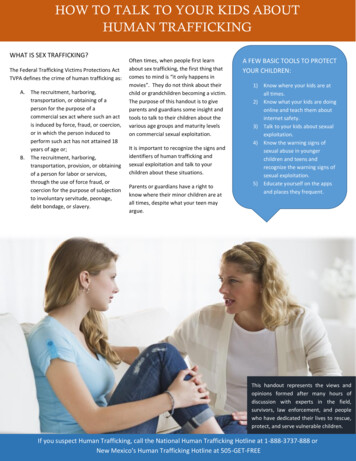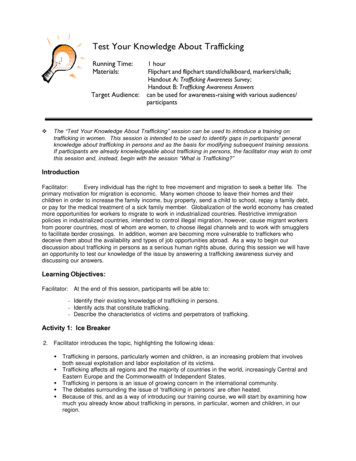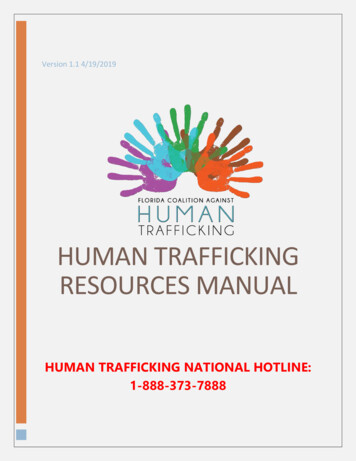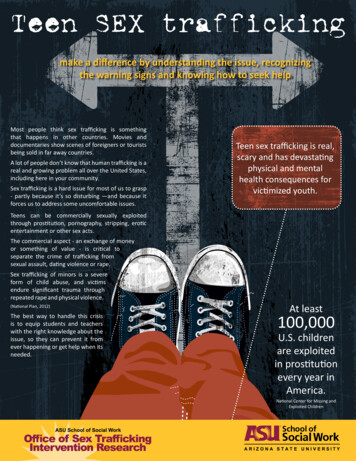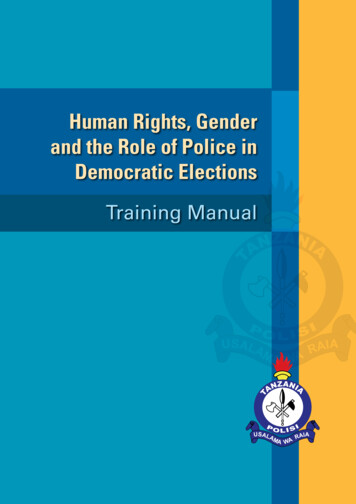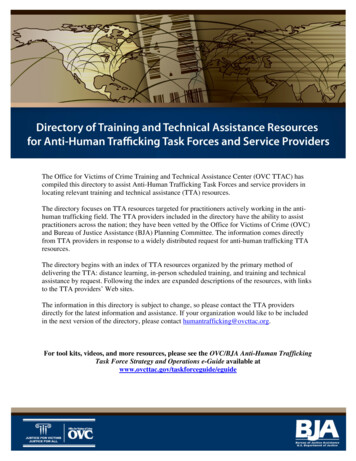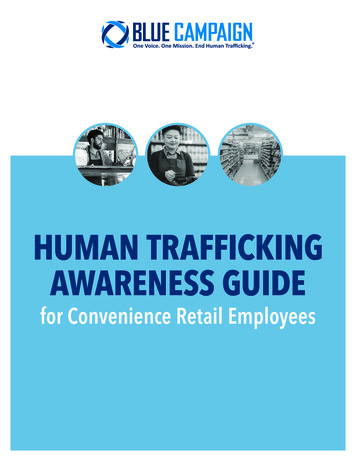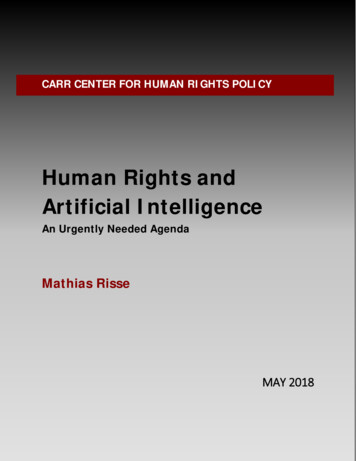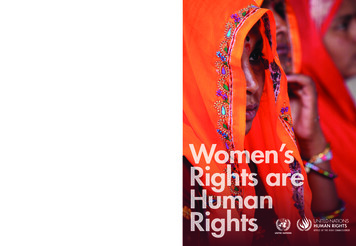
Transcription
Human Rights and Trafficking in Persons: A HandbookConsultants/AdvisorsLin ChewAnn JordanPrincipal WriterElaine PearsonLayout and DesignIndochina PublishingCover designMonique AuricchioCopyright 2000 by Global Alliance Against Traffic in WomenInternational Secretariat:191 Sivalai CondominiumItsaraphap Rd, Soi 33Bangkok 10600 ThailandTel: 662 864 1427/8Fax: 662 864 1637Email: gaatw@gaatw.orgWebsite: http://www.gaatw.orgAll rights reserved. No part of this publication may be reproduced in any form without theprior permission of the publisher, except for the quotation of brief passages in reviews.ISBN:Printed in Bangkok, ThailandDecember, 20001
PREFACETrafficking in persons is an issue of growing concern from the international community.International organisations, regional bodies and national governments are working onprogrammes and policies, creating new laws and regulations to stop trafficking of persons.It is sad to see that most of these initiatives and actions are of criminal concern andgrossly neglect the human rights of trafficked persons. They protect the interest of thestate, rather than the interest of the affected people. Hence, trafficked persons are veryoften revictimised in the remedial process.People who are working with trafficked persons need to be concerned with the basic rightsof victims of trafficking. They must see the necessity to shift the working paradigm fromone of criminal sanction to human rights promotion. Activists working on the traffickingissue need to know the human rights principles, international instruments and mechanismsto ensure that every step they take does not further violate the rights of trafficked persons.The Global Alliance Against Traffic in Women (GAATW) has organised trainings foranti-trafficking activists on human rights in the context of trafficking since 1996. Ahandbook entitled Human Rights Action in the Context of Trafficking in Women wasproduced after the first training for activists from Asia and Eastern Europe in 1997. Aftertwo more trainings, participants from each met in Geneva in June 1999 to share theirthoughts and ideas for the formulation of this new handbook.NGO activists from each region, who are working in their own capacity to eliminate thisform of modern slavery, firmly believe that a solution to the problem cannot be foundunless human rights of trafficked persons are respected and promoted by all stakeholders.The struggle for human rights of trafficked persons will make states more accountable forthis crime against persons. It will also encourage participation and respect for the right toself-determination of affected persons.Siriporn SkrobanekOctober 20002
ACKNOWLEDGEMENTSGAATW would like to acknowledge everyone involved in the production of theHandbook. We would especially like to express our deepest gratitude to the consultants onthe Handbook, Lin Chew of the Asian Human Rights Commission and Ann Jordan of theInternational Human Rights Law Group, for sharing their expertise and giving importantcritical input into the development of the Handbook at every stage of the project. Withouttheir continuous commitment, guidance and support, producing the Handbook would nothave been possible. We would also like to thank Elaine Pearson who wrote the text.We are also grateful to Women Law and Development International for kindly allowingus to reproduce excerpts from their fabulous manual Women's Human Rights Step by Stepin Chapter IV of the Handbook.Thanks to the following organisations who responded to requests for additionalinformation and case studies:All African Women for Peace (South Africa)Fundacion ESPERANZA (Colombia)Campaign for Migrant Domestic Workers (USA)Women, Law and Development in Africa (Ghana and Kenya)Foundation for Women (Thailand)UNICEFUNIFEMUNESCOWomen's Consortium of Nigeria (Nigeria)We also acknowledge and thank those organisations that participated in the LatinAmerican and African Regional Consultations, and that gave important feedback on theHandbook in its final developing stage:All African Women for Peace (South Africa)Centro Humanitario de Apoio a Mulher (Brazil)Centro de Orientacion e Investigacion Integral (Dominican Republic)Confederacion Latinoamericana y del Caribe de Trabajadoras del Hogar (Bolivia)Fundacion Esperanza (Colombia)Girl's Power Initiative/International Reproductive Rights Research Action Group(Nigeria)Mujeres por la Salud en Accion Contra El Sida AC (Mexico)Proyecto Esperanza (Spain)Women, Law and Development in Africa (Kenya)Women's Consortium of Nigeria (Nigeria)Women Trafficking and Child Labour Eradication Foundation (Nigeria)Young Women's Christian Association (Zambia)Finally, we sincerely appreciate the generous financial support from Heindrich BoellFoundation, Germany, which made the regional human rights trainings and consultationsand indeed the production of this Handbook possible.3
CONTENTSINTRODUCTIONCHAPTER IHUMANRIGHTSPRINCIPLES,GOVERNMENTOBLIGATIONS AND TRAFFICKING IN PERSONSA. WHAT ARE HUMAN RIGHTS?1. Human Rights Principles of Universality, Inalienability andIndivisibility2. Women's Rights are Human Rights3. Children and Human Rights4. Government responsibility and accountability5. Primary Human Rights InstrumentsB.1.2.3.CHAPTER IIWHAT IS TRAFFICKING?Historical Background of Trafficking in PersonsThe Modern Definition of TraffickingComplexity of issuesCONTRIBUTINGFACTORS,CONSEQUENCESRECOMMENDED GOVERNMENT RESPONSESANDA. FACTORS CONTRIBUTING TO TRAFFICKING1. Economics - Economies in Transition2. Migration and Feminisation of Migration3. Gender-based discrimination4. Development strategies: Growth of entertainment sex industry5. Laws and policies on migration6. Armed Conflict7. Corrupt Authorities8. Religious and Cultural PracticesB. CONSEQUENCES OF TRAFFICKING1. Crimes Committed by Traffickers2. Human Rights Violations Committed by GovernmentsC. RECOMMENDED GOVERNMENT RESPONSES: HUMANRIGHTS STANDARDS FOR THE TREAMENT OFTRAFFICKED PERSONS1. Where did the HRS come from?2. What are the HRS? Cases from the Field and the need for theHRSCHAPTER IIIAPPROACHES AND STRATEGIES:PRINCIPLES AND GUIDELINESA. STRATEGIES1. Strategies at many levels and for diverse actors2. Current Strategies3. Basic principles for Human Rights Action: participation and selfrepresentation4
4. International principlesB. DIFFERENT APPROACHES AND STRATEGIES1. The Moralist approach2. Crime control approach3. (Illegal) Migration approach4. Labour approachC.RIGHTS-BASEDSTRATEGIESTOTRAFFICKING1. Prevention of Trafficking2. Prosecution of Traffickers3. Protection of human rights of trafficked personsCHAPTER IVADDRESSNGO STRATEGIESA. NGO STRATEGIES AT MANY LEVELS AND FORDIVERSE ACTORSB. A GUIDE TO INVESTIGATING AND REPORTINGVIOLATIONS OF HUMAN RIGHTS IN THE CONTEXT OFTRAFFICKING1. Preparation.2. Fieldwork / Investigation3. Follow-up and AnalysisC. A GUIDE TO BUILDING AN ADVOCACY STRATEGY1. Knowledge of the issue2. Leadership & Organization3. Strategy4. Communication and Education5. Mobilization and Action6. Progress towards Goal7. Design, Implementation and EvaluationD. CONCRETE ACTIONS: SOME SUGGESTIONS1. Local Level2. Regional level3. International level5
INTRODUCTIONThis Handbook has several objectives. Firstly, it aims to inform readers about humanrights violations in the context of trafficking in persons, by providing conceptual clarityon human rights and trafficking in persons. Secondly, it shows how to develop strategiesto combat trafficking from the human rights perspective. The Handbook gives ideas forconcrete strategies to be carried out at all levels, from local to international. Finally, it actsas a resource tool, and is a guide to international instruments and other materials relevantto trafficking.The Handbook is intended for NGOs, activists and persons who come into contact withtrafficked persons or who are interested in the issue of trafficking. Trafficking is a globalphenomenon, and GAATW as an international organisation hopes this book is useful forreaders from all parts of the world. This is a broad-based manual, containing generalstrategies that can be further adapted to local contexts. The Handbook was developed outof regional human rights trainings held for Asia and Eastern Europe, Africa and LatinAmerica. In GAATW's 1999 Global Evaluation Meeting on the regional human rightstrainings, participants from each of the trainings agreed that defining specific actions isvery dependent upon the regional context. One handbook could not successfully orcomprehensively or effectively cover the situation of trafficking in each region. Thuswhilst this handbook intends to cover the common issues of trafficking universalthroughout the world, handbooks more suited to the local conditions of particular regionswill be developed separately.We received important critical input and feedback on the draft of this manual from antitrafficking activists working in Latin America and Africa, at regional consultationsorganised in September-October 2000. Suggestions were incorporated into the draft andwe have included case studies from all regions so as to illustrate the diversity ofexperiences of different countries. The regional consultations organised in Africa andLatin America also discussed development of the regional handbooks, and plans havebeen made for these to be developed in 2001. Another book, Human Rights in Practice,developed from GAATW's South East Asian trainings has already been developed tocover the Asian region and is available from GAATW.This Handbook aims to present trafficking through the human rights framework. Thusthere is a need to understand the human rights framework to understand the concept oftrafficking as involving fundamental human right violations. When we think about "whatis trafficking" we need to do so from the perspective of human rights, that is how we getto our definition of what "trafficking" is.Chapter One introduces the core concepts of human rights and the articles of the maininternational instruments relevant to trafficking. The concept of trafficking is introduced,with discussion on past and present definitions. The definition used by GAATW isclarified and the elements illustrated through the use of case studies.Chapter Two contains the main contributing factors of trafficking. It deals with theconsequences of trafficking in terms of crimes committed by traffickers andrecommended government responses. In this respect, the Human Rights Standards for theTreatment of Trafficked Persons (HRS) is introduced and explained through the use ofcase studies.6
Chapter Three discusses the fundamental principles that should guide the formulation ofstrategies for rights-based action on trafficking. It suggests how, even from differingapproaches to the problem, action can be taken to enhance and protect the rights oftrafficked persons.Chapter Four deals with NGO strategies at all levels. It contains guides on a step by stepbasis of how to develop research and advocacy strategies. There are examples ofappropriate anti-trafficking strategies at the local level. It also acts as a guide to variousregional and international mechanisms that are relevant to trafficking. Recommendationsare made concerning how to best activate and use the HRS at all levels.Finally, the Handbook is just that: a Handbook. It is a resource material on human rightsand trafficking in persons and as such is not necessarily intended to be read from cover tocover. We hope it is useful tool for organisations working on trafficking and related-issuesthroughout the world.GAATW7
CHAPTER IHUMAN RIGHTS PRINCIPLES, GOVERNMENTOBLIGATIONS AND TRAFFICKING IN PERSONSA. WHAT ARE HUMAN RIGHTS?The concept of "Human Rights" is a powerful tool. One hundred eighty-nine countries aremembers of the United Nations. As such, these governments have made a commitment tothe human rights principles enshrined in the United Nations Charter and in the UniversalDeclaration of Human Rights1 (UDHR, 1948). The UDHR establishes the principle thatfundamental human rights and basic freedoms are guaranteed to all persons. Civil societyneeds to understand the nature of human rights and governments' responsibility to protectthese rights. This knowledge provides civil society with a basis upon which to demandgovernments take actions to protect the human rights of all persons, including traffickedpersons. All of us can educate and lobby our governments on how to fulfil theirresponsibility to uphold and make real the UDHR principles for all people. This chapterintroduces the basic principles of human rights and the primary instruments addressing thehuman rights abuses suffered by trafficked persons.1. Human Rights Principles of Universality, Inalienability and Indivisibility.Human rights are universal, inalienable and indivisible. Human rights exist in the civil,political, economic, social and cultural spheres. Examples of human rights are the right tolife, the right to work and a decent living, the right to freedom from discrimination and theright to education. They are based on fundamental principles of respect for human dignity,equality and non-discrimination.Universality means that human rights belong to everyone, everywhere, and they are thesame for all people. Rights exist without distinction, for example, without regard tonationality, race, sex, religion, class, ethnicity, language or age. All people have the samebasic needs and rights, which need to be upheld and protected at all times.Inalienability means all rights belong to all persons from the moment of birth. We areborn with rights and governments should assert human rights principles. No governmentor person has the right to deny anyone's basic human rights.Indivisibility means all human rights are related to each other; consequently rights areinterrelated and interdependent. Civil, political, economic, social and cultural rightscannot be viewed as unconnected. They complement each other. One right is not moreimportant than another, and one person's rights are not more important than anotherperson's rights. The right to speak, or the right to choose the number and spacing of yourchildren, is interdependent with other rights, for example, on the ability to obtaininformation, and equal rights within the family. No one set of rights can be sacrificed foranother.2. Women's Rights are Human RightsWe specifically mention women's rights because, although all persons, regardless ofgender, are entitled to enjoy all basic human rights, women are often denied these1http://www.unhchr.ch/html/intlinst.htm8
rights simply because they are women. In the context of trafficking, many basic rightsof women are violated e.g. the right to be free from all forms of discrimination. Due tothe unequal nature of gender relations, women and girl-children form the majority ofthose who are trafficked."The human rights of women and the girl-child are an inalienable, integral and indivisiblepart of universal human rights the human rights of women should form an integral partof the United Nations human rights activities, including the promotion of all human rightsinstruments relating to women"2. This statement, from the 1993 Vienna Declaration onHuman Rights, represents the first official recognition that women's rights are humanrights by the international community.Saying 'women's rights are human rights' is not claiming ‘special rights’ for women. Onthe contrary, it is a call to recognise that women have the same basic human rights as men.Many women are deprived of their rights because some societies consider women inferiorto men and deny them access to justice, participation in political life and the ability tomake personal life decisions.The traditional debate on, and interpretation of, human rights, has focused on men'sactions in the public sphere, such as repression of political speech and politicalparticipation. Women’s rights have been largely ignored in this debate, because womenare typically seen as actors in the private sphere. As a result, their participation in thepublic sphere has been largely curtailed, and in the private sphere, controlled. Therefore,in fighting for women's rights, we are trying to make the picture whole, in claiming allrights for all women.To ensure that women enjoy all the rights they have, a good starting point is to examinethe particular obstacles faced by women. For instance, although the right to education isan universal right for all human beings, girls are more likely than boys to be uneducated.In times of poverty, parents tend to send boys to school rather than girls. Some culturesvalue males more than females, and males are expected to be major breadwinners in thefamily. Also, women tend to be at risk of being treated as property, sexually harassed orabused more than men, even though individual freedom and the right to safety andsecurity are rights for all.Trafficking of women and girls is directly linked to the failure, sometimes the refusal, ofgovernments to accord women the same basic human rights as men. Women who havebeen denied the right to education and legal rights are denied the right to control their ownlives. Unskilled and unable to be economically independent, such women are especiallyvulnerable to trafficking.3. Children and human rightsChildren have human rights in the same way that adults do. Children's rights are of equalvalue to adults' rights. However, some human rights have a special application to children,reflecting their need for special care and attention, their vulnerability and the differencebetween childhood and adulthood. Childhood in itself has a value. To recognise this, whenwe talk about human rights of children, the best interests of the child should be a primaryconsideration in all actions concerning children, over the interests of a parent or a state.2Vienna Declaration and Programme of Action, A/CONF. 157/23,adopted on 12 July 1993, para18. mbol)/A.CONF.157.23.En?OpenDocument9
The human rights of children including the "best interests" principle are set outcompletely in the Convention on the Rights of the Child. This Convention and the articlesrelevant to trafficking are laid out later in this Chapter. We mention children here,because as a group they are also very vulnerable to being trafficked, and it is important torecognise that as children they have special rights for their protection. Strategies adoptedto address trafficking in adult persons will not always be appropriate for trafficking inchildren (see later in this Chapter "Children as trafficked persons").4. Government Responsibility and AccountabilityStates have a responsibility to provide protections to trafficked persons pursuant to theUniversal Declaration of Human Rights and through ratification or accession to numerousinternational and regional instruments. Government accountability is the obligation andresponsibility a government has to uphold human rights under international and nationalsystems of law. Governments have the obligation and responsibility to ensure theprotection of all human rights for all individuals and to prosecute individuals andgovernment officials who violate the rights of others. So in the context of trafficking, agovernment is responsible for acts committed by its own actors, such as immigrationofficials, border patrols or police.3 Individuals can hold governments accountable underinternational laws embodying human rights principles.The concept of "due diligence" is sometimes mentioned as the standard by whichgovernment responsibility for violation of human rights by non-State actors is assessed.Governments that have signed human rights treaties are responsible to act with duediligence (or good faith) to prevent, investigate and punish any violation of rightsrecognised by those treaties. They are also required to provide a mechanism to restore theright violated and provide compensation as warranted by the damages resulting from theviolation.4 Due diligence in the context of trafficking means governments have a duty toprovide protection to trafficked person according to their obligations under internationallaw. So governments must apply the due diligence principle in ensuring effectiveprevention of trafficking, prompt and thorough investigation, and prosecution oftraffickers and compensation for the trafficked person.5Human rights are further protected in many national constitutions and in nationallegislation of countries all over the world. Governments are bound to respect, ensure/protect and promote the rights of all people:3Economic and Social Council, Integration of the Human Rights of Women and the GenderPerspective: Report of the Special Rapporteur on Violence Against Women, its causes andconsequences, Ms. Radhika Coomaraswamy, on trafficking in women, women's migration andviolence against women, submitted in accordance with Commission on Human Rights resolution1997/44, E/CN.4/2000/68, 29 February 2000 at para 50. nt4Id. at para 51 referring to Velasquez Rodriquez case, Judgement of 29 July 1988, InterAm.Ct.sR.(Ser. C) No.4, 1988, para 167.5Id. at para 53. Refer to this document for a more detailed explanation of "due diligence" in thecontext of trafficking.10
a. Respect: Governments must refrain from violating the human rights of individualsand take actions to uphold human rights principles. Governments shall not violatehuman rights of people in their territories in administering the nation's activities. Forexample, immigration officials, military and police must not violate the human rightsof any person, including undocumented migrants and trafficked persons.b. Ensure/Protect: Governments must ensure that their laws and policies do not permitany person to violate the human rights of any other person (including non-citizens).Governments have a duty to punish all perpetrators, including government officials,private actors, corporations, religious groups and other entities.It may be difficult to document and monitor the steps a government takes to ensureand protect human rights, especially if civil society is unaware of the existence ofhuman rights principles and government obligations. Human rights violations againstundocumented migrants and trafficked persons are particularly difficult for civilsociety to monitor, because trafficked persons are not visible in the public sphere.Trafficked persons may not have legal working documents and thus work inunderground sweatshops or factories. They may work in an occupation, such as thethe sex industry, that is illegal in many countries. They may be in sectors that are inthe private sphere, such as domestic work or marriage. However, governments areresponsible for ensuring protection of human rights in all these spheres.c.Promote: Governments must ensure that people know their rights and how toexercise their rights. Governments must promote conditions on their territories thatallow people to exercise their rights, such as providing education, upholdingdemocracy, ensuring economic justice and allowing NGOs to criticise thegovernment's human rights record. A country's laws must not restrict the freepromotion of human rights; for example, no law should restrict people's access toknowledge about their basic rights.United Nations SystemWhat is the United Nations?The United Nations (UN) is a worldwide organisation made up of 189 governments ofrecognised countries of the world. Its headquarters are in New York and Geneva. It is theformal international system that monitors human rights implementation and violationsworldwide. By understanding the nature of human rights and the governments'responsibility to protect human rights, we can demand action be taken on behalf oftrafficked persons. We can pressure governments to fulfil their commitments under theUniversal Declaration of Human Rights.UN InstrumentsSeveral types of instruments operate in the UN. Some of these are: treaties (including conventions) declarations resolutions protocolsTreaties are legally-binding conventions or covenants. Once signed and ratified by11
countries, they impose the highest possible level of obligations on governments. Mosttreaties are accompanied by recommendations, which are documents explaining how atreaty should be interpreted and applied.Protocols are additions to treaties that usually must be agreed to separately from the treatyitself. They also impose the highest level of obligations on governments.Declarations are not binding, but give an indication of international political commitmentto an issue.Resolutions are formal statements of persuasive value calling for action, but are notbinding upon States.A State Party is a country that has ratified (signed and agreed to be bound to) a treaty.Earlier we mentioned the Universal Declaration of Human Rights (UDHR). Countries donot ratify the UDHR as they do treaties. The principles of the UDHR are included in twocovenants, the International Covenant on Civil and Political Rights and the InternationalCovenant on Economic, Social and Cultural Rights. In this way, they are made binding astreaties. Also, nowadays the UDHR is binding as part of customary international law(adhered to out of custom and thus treated as law).5. Primary Human Rights InstrumentsAll human rights treaties apply to all persons. Certain provisions of some human rightsinstruments are especially relevant to the situation of trafficked persons. This is true evenif the documents do not specifically mention 'trafficking'. Many governments have signedthese instruments and so have made commitments to protect and promote the rightscontained in those instruments. All of the instruments below can be found on the internetat http://www.unhchr.ch/html/intlinst.htm. You can find out whether your government hassigned the following instruments by checking http://www.unhchr.ch/tbs/doc.nsf (status ofratifications by country). If you do not have access to the web, you can contact yourMinistry of Foreign Affairs.The UN has established committees for different treaties to monitor the progress ofcountries that have signed them. Countries are required to submit reports to thesecommittees. The reports describe how the country is currently taking action to uphold therights contained in that treaty. Chapter IV of this Handbook gives suggestions about howNGOs can participate in the committee review of their country's reports.Human rights of persons are violated by governments in three ways: Laws that permit or encourage discriminatory practices against women or others, andhinder the ability of individuals to develop their full human potential;Actions taken by government officials or employees that violate human rightsprinciples;Failure to prosecute public officials and private actors, including traffickers, and, intrafficking cases, failure to recognize and protect the rights of all persons, especiallytrafficked persons during the post-trafficking period.12
These actions violate recognised human rights that are located in a number of humanrights instruments. Below are the main instruments that set out the human rights applyingto everyone; men, women, trafficked persons and migrants. The following tables list themore common rights which are violated in the context of trafficking. Human rightsviolations suffered by trafficked persons are so extensive that it is necessary to look at allmajor human rights instruments. The names of the relevant committees reviewinggovernment compliance are set out below each table. The instruments are listed in orderof their significance at the international level.You may wish to refer back to this section again after reading part B of this chapter ‘Whatis trafficking.²a. International Covenant on Civil and Political Rights (1966)Article23789121426No distinction based on sexEqual rights for men and women in the enjoyment of civil and politicalrightsNo cruel, inhumane or degrading treatmentProhibition on slavery and servitudeRight to liberty and security of person; no one shall be subject to arbitraryarrest or detentionFreedom of movementEquality before the courts and tribunalsEqual before the law, equal protection of the lawMonitoring body is the Human Rights Committee.b. International Covenant on Economic, Social and Cultural Rights (1966)Article2367101112No distinction based on sex, nation or social originEqual rights for men and women in the enjoyment of economic, social andcultural rightsRight to do work that one freely chooses under conditions protectingfundamental freedoms of the individualRight to just and favourable conditions of workMarriage must have consent of both partiesRight to adequate standard of living including food, clothing, housingRight to physical and mental healthMonitoring Body is the Committee on Economic, Social and Cultural Rights.c. Convention on the Elimination of all Forms of Discrimination Against Women(Women's Convention, 1979)Article269States must eliminate discrimination by any person, organisation or enterprise andmust abolish discriminatory laws, regulations, customs and practicesState parties shall take all appropriate measures, including legislation, to suppressall forms of traffic in women and exploitation of prostitution of womenMarriage shall not automatically change nationality13
1112141516Right to free choice of employmentRight to health care and servicesProtection for women in rural areasEquality before the lawRight to freely choose a spouse, minimum age for marriageMonitoring Body is the Committee on the Elimination of Discrimination against Women(CEDAW). CEDAW and its mechanisms are discussed further in Chapter IV.d. Convention Against Torture and other Cruel, Inhuman or Degrading Treatment orPunishment (1984)Article131314Torture is an act where severe pain or suffering, physical or mental, isintentio
the Handbook, Lin Chew of the Asian Human Rights Commission and Ann Jordan of the International Human Rights Law Group, for sharing their expertise and giving important critical input into the development of the Handbook at every stage of the project. Without their continuous commitmen
